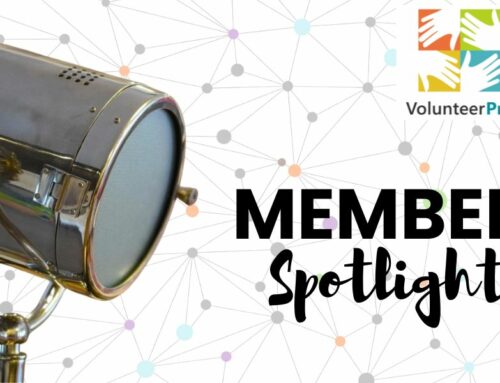Create An Easy Volunteer Engagement Strategy in 6 Steps
Inside of our VolunteerPro Premium Membership community, we are in month three of our Total Transformation Series. This seminar series is specifically designed to help our members become a better “architect of the volunteer experience” and build a volunteer engagement strategy that generates real impact.
Through the Total Transformation Series, our members have been learning the key steps they need to take to transform their efforts from fundamental to fully strategic volunteer engagement, with a mature approach.
To help you get a handle on the key elements you need for success, we’re giving you a peek inside to see what we have planned!
Compare what you have working for you at your organization and see where you stack up and where you have work to do.
Continue reading and you will learn the 6 key planning action steps you need to take to develop a best-in-class volunteer program that drives engagement:
Step 1: Map Out Your Goals
Step 2: Create a Risk Management Plan
Step 3: Create an Operations Plan for Volunteer Services
Step 4: Define Your Key Outcomes Metrics and Targets
Step 5: Design a Blended Volunteer Training Plan
Step 6: Create a Recognition and Retention Plan
How Does Your Current Volunteer Engagement Strategy Stack Up?
Before you go through the 6 key planning steps for your volunteer program, review the following five phases to effective volunteer management in more detail.
Then, assess where your organization’s volunteer engagement strategy currently stands and where you can make improvements for better results.
Consider the following questions:
- How can you ensure that your agency has an engaged, enthusiastic, prepared, and committed team of supporters to help meet your most critical agency goals?
- Where can you invest in building better systems of success?
- Where is there untapped potential? Who on your team can help realize it? And, what support will they need to act quickly and confidently to reach success?
Phase One: ENVISION THE FUTURE (Not This, But That)
Focused Intention, the Miracle Mindset, & a Smart Plan to Support Your Program Goals
In this phase, take steps to gain clarity on your vision for volunteer engagement, its current state, and how your strategy can better align with your agency’s current and future goals and objectives. This is a critical phase because it paints a picture of the promise of what is possible when it comes to volunteer engagement at your agency. It is also an excellent time for employees who work with volunteers to reflect on their own leadership philosophies, which will set the stage for future decisions and actions
Phase TWO: BUILD THE FOUNDATION (Program Development)
Essential Program Development Elements to Support Long-Term Success
In this phase, you take steps to build the essential blueprint, or volunteer management system, that will guide the implementation of your volunteer strategy. While these elements may evolve over time, they should offer a clear picture of standard operating procedures and should guide the actions of volunteers and employees. These elements should be reviewed by and approved by agency leadership and your board of directors.
Phase THREE: GROW ENGAGEMENT (Volunteer Recruitment)
Modern Recruitment Strategies to Attract a Diverse Fanbase of Supporters
In this phase, you take steps to set goals for the number and kinds of volunteers you hope to engage and put into place a marketing and onboarding system that can help you get there. You specify the ideal volunteers you hope to mobilize and develop a strategy to build a fanbase using online and on-land tactics to reach volunteers where they are at and inspire them to take action. It is crucial in this stage that digital tools and strategies are leveled up to build awareness and visibility and communicate with volunteers where they can be found online.
Phase FOUR: SUSTAIN INVOLVEMENT (Volunteer Retention)
Improving the Volunteer Experience & Retaining High-Impact Volunteer Talent
In this phase, you set a purposeful plan to retain volunteer talent and amplify the impact of their work. This phase includes volunteer training, supervision, and recognition activities, but it also includes your strategy for inspiring deeper commitment, ownership, leadership, and accountability. Understanding volunteer perceptions is key to pinpointing motivations, so you also gather survey data and make decisions based on actionable volunteer feedback.
Phase FIVE: SCALE LEADERSHIP (Ownership & Accountability)
Purposeful Development & Support for Greater Ownership & Accountability
In this phase, you take steps to delegate and distribute responsibility for generating exceptional volunteer experiences throughout your team. As volunteer engagement grows at your agency, it will be impossible to keep tabs on everything. A trained and highly-effective team of volunteer leaders can help you scale your network and impact exponentially. You will also need to develop mutually-beneficial internal and external partnerships to help you meet your goals.
After becoming familiar with these five phases ask yourself: where do your strengths lie? And, where are areas you need to improve to get greater traction, with less stress and uncertainty?
6 Key Planning Steps for an Impactful Volunteer Engagement Strategy
Many volunteer managers are struggling with how they can build strategic volunteer engagement that is better than ever before.
It’s no hyperbole to say that the past 18 months have left us changed. And, when society evolves, so too must volunteerism.
Times like these leave us to take a second look at things.
You might question…
- Where should I focus my limited energies and resources for the greatest return?
- What should I include in strategic volunteer engagement to drive results and success?
- What should I let go of that is no longer serving my organization or my volunteers?
- What infrastructure is needed to keep my volunteers happy, productive, and engaged over the long term?
- And what tools and skills do I need to have on hand to build it?
And, we’ve got some answers with our 6 steps to a simple, yet impactful, volunteer engagement strategy!
Step One: Consider Your Goals
A BIG part of planning strategic volunteer engagement is setting the right targets. After all, if you don’t know where you’re going, chances are you won’t get there.
By setting and communicating a set of specific stretch goals, your team will know what the priorities are and what they will be accountable for.
Make sure your goals related to volunteer engagement also directly align with your organization’s strategic plan.
A lot has changed over the past year. How can volunteers be re-deployed to help the organization build back stronger than before? What roles need to be changed and which will stay the same? What new proacts or initiatives need to be added to address emerging gaps?
Step Two: Embrace and Manage Risk
Proper risk planning is an important foundation to better program policies. What’s more, when volunteer programs embrace and manage risk effectively, they also realize the rewards of increased quality of service to their membership, community, and cause.
Risk management is more than just keeping bad things from happening – it can also help you make better planning and management decisions and support the growth and sustainability of your nonprofit organization.
As a leader, you need to get your ducks in a row quickly and without confusion.
Here are some suggestions to get you started:
First, identify the 5 kinds of risks associated with volunteer involvement.
Review the list below and brainstorm some risks that might be present in each category.
- People – the possibility of inappropriate volunteer-client/caregiver boundary setting
- Property – theft, loss, damage to equipment
- Reputation – the damage to your community credibility
- Income – the loss of grant or contract funding, as well as individual giving
- Liability – for supporting the health and safety of volunteers, employees, partners, and clients
Now that you have list of potential risks, prioritize them to determine which ones are most important for your organization to address.
Then, choose the right strategies to manage risks with a high magnitude of harm
If you choose to move forward with an action that may involve risk, management strategies can be put in place to reduce or mitigate harm. This does not always mean that harm is eliminated.
After determining which risks you will want to combat and how, you’ll want to brainstorm a list of new or revised volunteer policies you need to develop, based on your chosen risk management strategies.
Step Three: Volunteer Operations Planning – A Blueprint for Your Success!
With the hustle and bustle of day-to-day tasks, it’s hard to find time to reflect on whether or not your current volunteer engagement strategy is the best one.
A solid volunteer operations plan can help you align your volunteer strategy with the goals of your organization and offer a clear blueprint for action that includes growth goals and the resources needed to realistically support them.
Here are some suggestions on what you should include in a full operations plan:
- Environmental Scan: Scan your organizational context or environment to determine which might have an impact on the plan’s success, positively or negatively. Consider what may need to be included in your plan for growth to ensure you are fully prepared and your plans aren’t blindsided.
- Goal Alignment: The most powerful and sustainable operations plan’s goals align across boundaries. Brainstorm a list of goals for your community, organization, and program.
- Philosophy of Volunteer Involvement: Your Philosophy of Volunteer Involvement should communicate the value of volunteers to an organization. This must be understood and agreed upon by the top levels of management.
- Your Risk Management Plan: Include your analysis, your priorities, and your policies/procedures.
- Targets, Goals, Outcomes: Include the top goals that are impacted by volunteer work and what will be reported regularly.
- Service Delivery: Include a detailed description about the roles volunteers will play in service or program delivery.
- Outreach & Marketing: Include your plan for reaching prospective volunteers.
- Your Volunteer Program Budget: Include your realistic budget and resource plan (including expenses and in-kind resources).
- Implementation Schedule: Include your accountability plan with due dates, milestones marking a significant change or stage in development, and when reporting will occur].
- Evaluation Strategy: In order to determine if your volunteer engagement strategy is working, you need to evaluate it! Include your strategy in your operations plan.
Without this guiding document, your organization may tend to manage volunteers in a reactive way, leaving leaders of volunteers without a rudder to keep on course.
Step Four: Track and Communicate the Value of Volunteers
Much the same as corporate shareholders seek positive growth in their financial portfolios, non-profit executives, volunteers, and donors want to see their investment in good causes reap rewards in the form of a social return on investment, or volunteer ROI.
The ability to explain the value proposition of volunteer services can help you more accurately paint a picture of volunteer effort while keeping stakeholders apprised of your progress. Having consistent, credible data on hand also builds trust and equips you to better advocate for respect and resources.
Have you been tracking volunteer hours, but want to do more? Have you been called upon to prove volunteer impact? Do you wonder what data is worthwhile to track, given your busy schedule?
Here are some suggested metrics you should start tracking and communicating to stakeholders:
- Number of volunteers
- Total volunteer hours
- Average hours per volunteer per month
- % of total volunteer roles filled or open shifts completed
- % increase in volunteer leaders
- Volunteer retention satisfaction or referral rate
- # of service beneficiaries reached (or reduced waitlist)
- % grant or strategic plan outcomes achieved
- In-kind & cash resources generated by volunteers
- Changes in beneficiary & volunteer condition/status, knowledge/learning, or readiness
When you have gathered your outcomes and metrics, it’s time to put them together in an impact portfolio.
Step Five: Build a Better Volunteer Orientation and Training Program
Reducing volunteer turnover and improving volunteer follow-through and accountability can all be accomplished with a better orientation and training program. But the job of adjusting human behavior for the good of all is a tall order that takes strategy, solid, planning, and skill.
Does your organization’s training both engage volunteers and improve the quality and consistency of the services they offer your organization?
If not, you might want to refresh your orientation training program so that your volunteers will be more prepared than ever to help and have fun doing so!
Follow our step-by-step plan to get you there:
Step 1: Develop learning goals that also help you evaluate whether your training worked
A learning objective is a statement that defines the expected goal of a curriculum, course, lesson, or activity in terms of demonstrable skills or knowledge that the learner is expected to acquire.
They must be real world, observable and measurable.
Step 2: Choose innovative “sticky” training elements that ensure skills are used. They should include a good mix of presentation, interaction, and self-reflection activities. It also helps to invite experienced volunteers to help build out your training with real-life case studies.
Step 3: Design a training program that primes volunteers for deeper engagement.
Include the following:
- Your goals and training objectives
- Your training activities
- Your training methods (live, online, hybrid, etc.)
- Any material/equipment that is needed
Step Six: Shower Your Volunteers with Appreciation and Gratitude
Showing your appreciation for volunteers on a regular basis isn’t just a “nice to have,” it’s a high impact volunteer engagement strategy.
Expressing gratitude regularly can boost volunteer satisfaction and, research shows, is a key driver of high volunteer retention rates. But how do you weave recognition into your daily practice, rather than reserving it for your annual celebration? And, what if you have a limited budget to work with?
There are many meaningful, low-cost ways to acknowledge the valuable work of volunteers in support of your mission throughout the volunteer lifecycle.
Here are a few ways to ensure you are hitting the mark:
- Align your strategy with six researched-based volunteer motivations
- Weave volunteer recognition into day-to-day practices
- Design formal recognitions events & programs with more meaning
- Develop a holistic, low-cost approach to recognition that gets support
Putting it All Together
So, there it is, the 6 steps you need to take to put together a solid volunteer engagement strategy.
How many of these do you have in place? And what are you most inspired about building next? Let us know in the comments!







